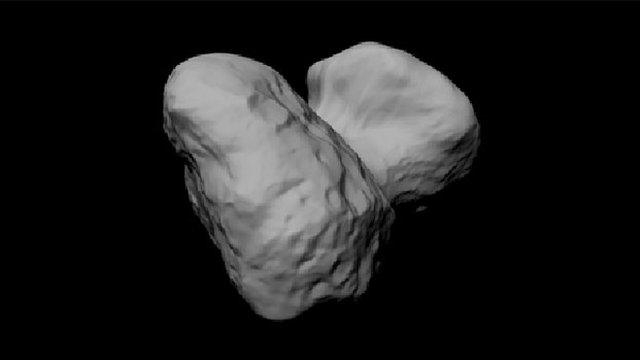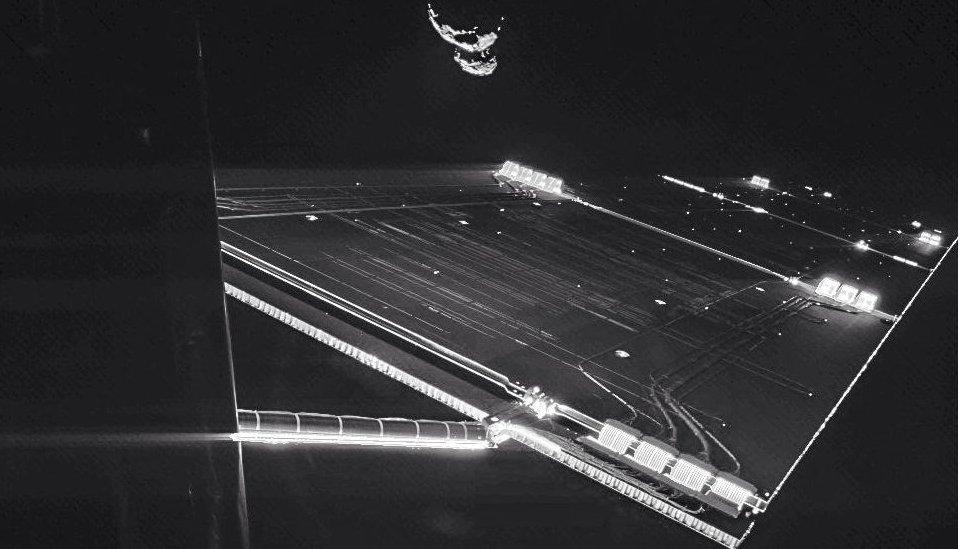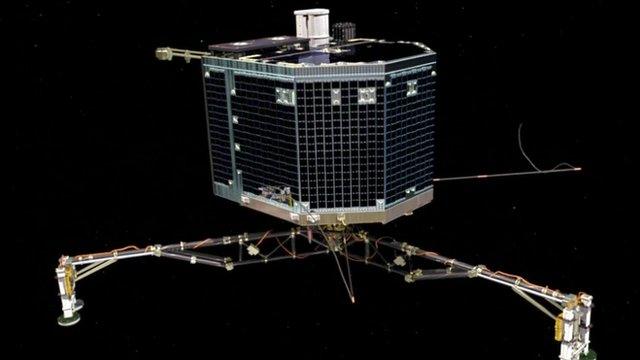Rosetta mission: Philae comet lander pictures its target
- Published
The Philae robot, soon to try to land on Comet 67P, has taken another dramatic image of its quarry.

Philae views 67P (top) from its attachment point on the Rosetta "mothership" (left). One of Rosetta's rectangular solar wings extends outwards
The picture is very similar to the one it acquired in mid-September - only this one is much closer, snapped from a distance of just 16km.
Also new in this picture is 67P's activity. Jets of gas and dust can be seen streaming away from the "neck" region of the rubber duck-shaped comet.
Philae is due to make its historic landing attempt on 12 November.
It is currently riding piggyback on its "mothership", the Rosetta probe.
You can just see the corner of this spacecraft on the left of the image, with one of its 14m-long solar wings dominating the foreground.
The plan is for Rosetta to eject Philae towards 67P just after 0830 GMT on the 12th.
The small gravitational tug from the 4km-wide comet should be enough to pull the robot on to its surface in a descent that is likely to take about seven hours to complete.
If the lander survives this fall, it will be a first. Never before in the history of space exploration has a soft touchdown been made on one of these "ice mountains".
David Shukman takes a close-up look at the Philae lander
The new "selfie" released by the European Space Agency is actually a composite of two images taken in quick succession but with different exposure times.
This allowed the very different contrast conditions to be balanced across the entire vista.
Philae acquired the frames on 7 October. It will be the last view from the robot's CIVA camera system until just after separation from Rosetta.
The plan is for Philae to grab a "goodbye" shot of Rosetta as the pair start to recede from each other.
Assuming the landing succeeds, CIVA will then take a full 360-degree panorama of its touchdown location.
This is a relatively flat terrain on the "head" of the duck, currently dubbed "Site J" after its position in a list of possible destinations in the site selection process.
Mission planners were due to meet on Tuesday to give a final confirmation to the J target. This ought to have been a formality.
The big caveat is if Rosetta has seen a "showstopper" in its recent close-in mapping campaign. This would have to be an extremely dangerous surface feature that had gone unrecognised in previous, lower-resolution imaging.
If a no-go situation has been indentified, planners would then move their attention to a back-up landing target on the "body" of the duck called "Site C".
Rosetta, Philae and Comet 67P are currently moving through space some 480 million km from Earth.
Comet 67P/Churyumov-Gerasimenko

Named after its 1969 discoverers Klim Churyumov and Svetlana Gerasimenko
Referred to as a "Jupiter class" comet that takes 6.45 years to go around the Sun
It gets as close as 180 million km from our star, and as distant as 840 million km
The icy core, or nucleus, is about 4km across and takes 12.4 hours to rotate
Rosetta has measured 67P to have a mass of roughly 10 billion tonnes
Its volume is 25 cu km, giving it a bulk density of 400kg/cu m - similar to some woods
Jonathan.Amos-INTERNET@bbc.co.uk and follow me on Twitter: @BBCAmos, external
- Published3 October 2014

- Published26 September 2014
- Published15 September 2014

- Published11 September 2014

- Published21 August 2014
- Published7 August 2014
